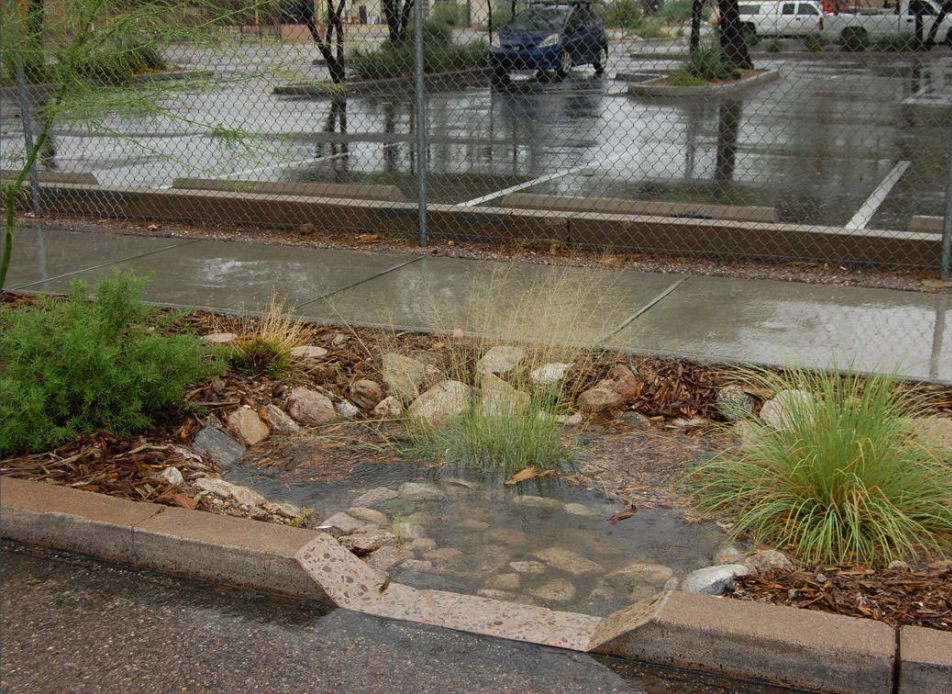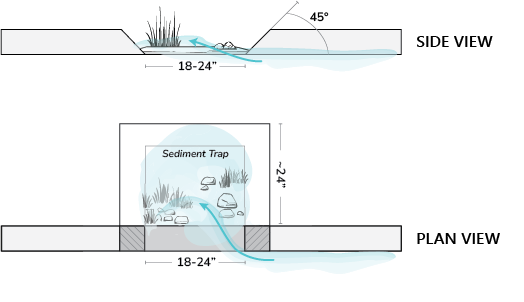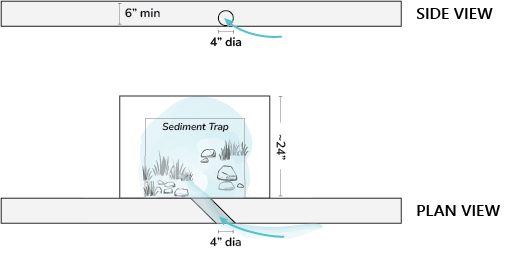Green Stormwater Infrastructure (GSI) in the Public Right-of-Way
Curb Cuts, Curb Cores, and Sediment Traps for Stormwater Infiltration
Storm Water Booster: GSI Curb Cuts

The City of Albuquerque is at the forefront of new ideas to beautify neighborhoods, reduce flood risks, improve groundwater, and support healthy urban gardens. Many streets in Albuquerque have a special ribbon of landscaping between the sidewalk and the curb. With a simple Green Stormwater Infrastructure (GSI) curb cut, you can irrigate that area with storm water and grow your garden.
GSI Curb Cuts help:
- Water flow to vegetation
- Reduce flood risk by slowing stormwater runoff
- Support urban ecology
- Beautify neighborhoods by bringing more water to support plants
How to Apply
To apply, please visit ABQ-PLAN and follow the process to apply for a "Curb Cut Request" permit application. Please see the design guidelines below for more information on the design requirements.
Voluntary Participation and Pilot Projects
Green stormwater infrastructure curb cuts and curb cores in the public right-of-way is a voluntary practice. For more information on permits or guidelines, please contact the Planning Department.
Design Guidelines
Curb Cuts and Curb Cores
What They Do
- Directs a portion of street runoff into vegetated basins or swales without major road reconstruction.
- Provides a low-cost retrofit option for existing neighborhoods to install GSI practices within the public right-of-way.
- Helps to reduce overall stormwater flow when installed at intervals along the street.
Where to Use Them
- On crested streets (highest in the middle) where runoff flows along the curb.
- In areas where runoff volume and direction are accessible using these methods and has been observed during rain events.
- Not permitted on streets with slopes over 3%.
Requirements
- Installation in the public right-of-way requires a permit and a licensed contractor.
- Curb cuts must be 2’ away from driveway aprons and 10’ back from intersections.
- To apply, please visit ABQ-PLAN and follow the process to apply for a "Curb Cut Request" permit application.
Curb Cut/Core Design Guidelines
- Place curb cuts or curb cores on the uphill side of a basin or swale to maximize water capture.
- For inlets, the bottom of the cut should slope slightly downward through the curb into the sediment trap
- Construct a sediment trap where water flows through the curb cut or curb core into the landscape to prevent soil erosion, road surface undercutting, and capture any sediment, debris or trash before it enters the infiltration basin or swale. Ensuring the top of the sediment trap is 1–2” below the bottom edge of the curb cut. Sediment traps can be constructed from large pavers, flagstone, or well-fitted 4”-8” rock.
- Two common types:
- Standard Curb Cut (18–24"): Sloped sides at 45°, bottom sloped toward basin.

- Curb Core (4" diameter): Angled drill core at 45°, starting just below street grade.

- Standard Curb Cut (18–24"): Sloped sides at 45°, bottom sloped toward basin.
Curb Cut/Core Maintenance
- Clear debris from the curb cut or curb core and sediment trap 3–4 times per year and after large storm events.
- Inspect curb cuts, cores and sediment traps after large storm events to ensure all features are functional and determine if maintenance or repair is needed.
- Inspect sediment traps, rock aprons and basin or swale annually for erosion and make repairs as needed.
Sediment Traps
What They Do
Sediment traps are small basins that capture sediment, debris and trash before it enters a larger bioretention or infiltration area, helping extend the life and function of the system. Sediment can fill up basins or swales and fine sediment can clog pore space reducing infiltration rates.
Where to Use Them
- At the inflow point of any green stormwater infrastructure feature redirecting flow from roadways.
- Often paired with curb cuts, curb cores and infiltration basins or swales.
- Construct a sediment trap where water flows through the curb cut or curb core into the landscape to prevent soil erosion, road surface undercutting, and capture any sediment, debris or trash before it enters the infiltration basin or swale.
Sediment Trap Design Guidelines
- Excavate an 8” deep depression about 2’x2’ just inside the curb cut or curb core.
- Install a 3–4” high earthen berm between the trap and the main basin.
- Use native grasses on the berm to stabilize soil and filter pollutants.
- Ensuring the top of the sediment trap is 1–2” below the bottom edge of the curb cut. Sediment traps can be constructed from large pavers, flagstone, or well-fitted 4”-8” rock. Create a lip on the backside of the sediment trap by placing a stone or paver vertically.
- A flat surface will make maintenance easy in quick with a square shovel. Rock lined sediment traps need additional maintenance to remove sediment buildup.
- Native bunch grasses should be planted on the back side of the sediment trap to help filter pollution from stormwater and slow the velocity of water entering the infiltration basin or swale.
Sediment Trap Maintenance
- Inspect inlets before and after rainy seasons to prevent blockages.
- Remove accumulated sediment as needed, 3-4 times a year and after large storm events for flat bottomed sediment traps.
- Remove sediment annually in rock lined sediment traps by removing rocks, clearing sediment and replacing rocks.
- Repair erosion along edges of sediment traps and berms annually.
Questions?
For more information on permits or guidelines, please contact the Planning Department.